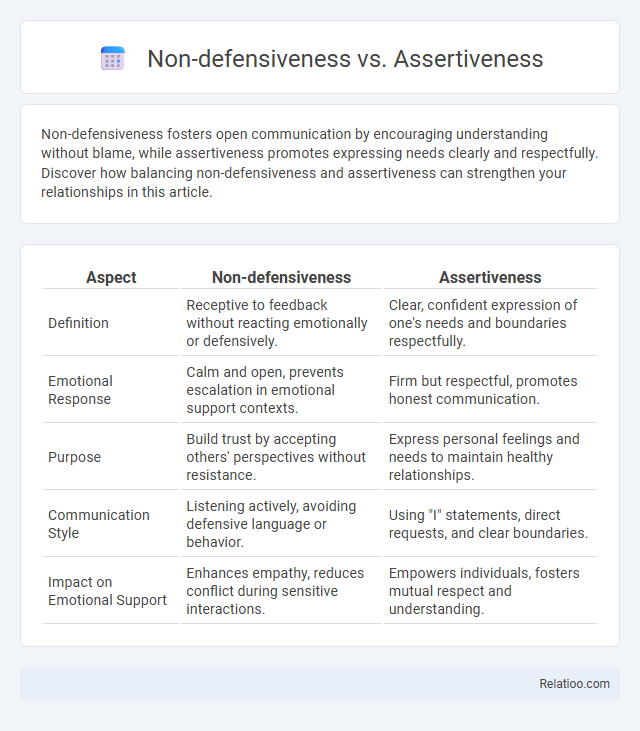Non-defensiveness fosters open communication by encouraging understanding without blame, while assertiveness promotes expressing needs clearly and respectfully. Discover how balancing non-defensiveness and assertiveness can strengthen your relationships in this article.
Table of Comparison
| Aspect | Non-defensiveness | Assertiveness |
|---|---|---|
| Definition | Receptive to feedback without reacting emotionally or defensively. | Clear, confident expression of one's needs and boundaries respectfully. |
| Emotional Response | Calm and open, prevents escalation in emotional support contexts. | Firm but respectful, promotes honest communication. |
| Purpose | Build trust by accepting others' perspectives without resistance. | Express personal feelings and needs to maintain healthy relationships. |
| Communication Style | Listening actively, avoiding defensive language or behavior. | Using "I" statements, direct requests, and clear boundaries. |
| Impact on Emotional Support | Enhances empathy, reduces conflict during sensitive interactions. | Empowers individuals, fosters mutual respect and understanding. |
Understanding Non-Defensiveness
Non-defensiveness involves maintaining an open mindset and calmly processing feedback without reacting emotionally, which helps in managing interpersonal conflicts effectively. Assertiveness, on the other hand, emphasizes expressing one's thoughts and feelings confidently and respectfully, balancing personal rights with others' needs. Understanding non-defensiveness is crucial for fostering constructive communication, as it allows individuals to engage with criticism or differing opinions without feeling threatened or undermined.
Defining Assertiveness in Communication
Assertiveness in communication involves expressing thoughts, feelings, and needs openly and honestly while respecting others' rights and viewpoints. Non-defensiveness refers to responding to feedback or criticism without anger or justification, promoting understanding and growth. Unlike non-defensiveness, assertiveness actively balances confidence and respect to maintain clear, effective, and respectful dialogue.
Key Differences Between Non-Defensiveness and Assertiveness
Non-defensiveness involves staying open and receptive to feedback without feeling threatened, whereas assertiveness means confidently expressing your thoughts and needs while respecting others. Your ability to remain non-defensive helps you listen effectively and reduces conflict, while assertiveness empowers you to set clear boundaries and communicate your perspectives. Key differences include the focus on internal emotional regulation in non-defensiveness versus the external communication skills emphasized in assertiveness.
The Role of Emotional Intelligence
Emotional intelligence plays a crucial role in distinguishing between non-defensiveness and assertiveness by enabling individuals to recognize and manage their emotions while responding calmly and confidently during conflicts. High emotional intelligence supports non-defensiveness by reducing automatic defensive reactions and promotes assertiveness through clear, respectful communication of needs and boundaries. Developing emotional self-awareness and empathy enhances interpersonal interactions, fostering both assertiveness and non-defensiveness for healthier relationships.
Benefits of Practicing Non-Defensive Behavior
Practicing non-defensive behavior enhances your ability to receive feedback objectively, fostering personal growth and stronger interpersonal relationships. This approach reduces conflicts and promotes open communication by encouraging active listening and empathy. Non-defensiveness supports emotional regulation, enabling you to respond thoughtfully rather than react impulsively, which benefits both personal and professional interactions.
Advantages of Assertive Communication
Assertive communication fosters clearer understanding and reduces conflicts by expressing thoughts and feelings openly while respecting others. It enhances self-confidence and promotes healthier relationships through honesty and directness. Unlike non-defensive or overly passive approaches, assertiveness balances expressiveness with empathy, leading to more effective interpersonal interactions.
Common Misconceptions About Non-Defensiveness and Assertiveness
Non-defensiveness is often mistaken for passivity, but it actually involves staying open to feedback without reacting emotionally, which differs from assertiveness that requires confidently expressing your needs and boundaries. Common misconceptions assume non-defensiveness means lack of opinion or weakness, while assertiveness is wrongly seen as aggression or dominance. Understanding these distinctions helps you communicate effectively without misunderstanding your intentions or compromising your personal boundaries.
Strategies to Cultivate Non-Defensiveness
Cultivating non-defensiveness requires recognizing triggers and consciously choosing to respond with openness rather than resistance, which reduces conflict and enhances communication. Techniques such as active listening, mindfulness, and reframing criticism as constructive feedback foster a non-defensive mindset, promoting emotional regulation and empathy. Implementing these strategies alongside assertiveness allows individuals to express their needs clearly without aggression, balancing self-expression with receptivity.
Techniques to Enhance Assertiveness
Enhancing assertiveness involves techniques such as using clear, direct language to express your thoughts and feelings while respecting others' boundaries. Practicing active listening and maintaining non-verbal cues like eye contact and open posture can strengthen your communication effectiveness. Your ability to balance confidence with empathy fosters healthier interactions and reduces non-defensive responses.
Balancing Non-Defensiveness and Assertiveness for Healthy Relationships
Balancing non-defensiveness and assertiveness is essential for fostering healthy relationships by allowing you to express your feelings and needs clearly without triggering conflict or feeling attacked. Non-defensiveness promotes open communication and emotional safety, while assertiveness ensures your boundaries are respected and your voice is heard. Mastering this balance enhances mutual understanding and trust, creating a foundation for constructive dialogue and stronger connections.

Infographic: Non-defensiveness vs Assertiveness
 relatioo.com
relatioo.com